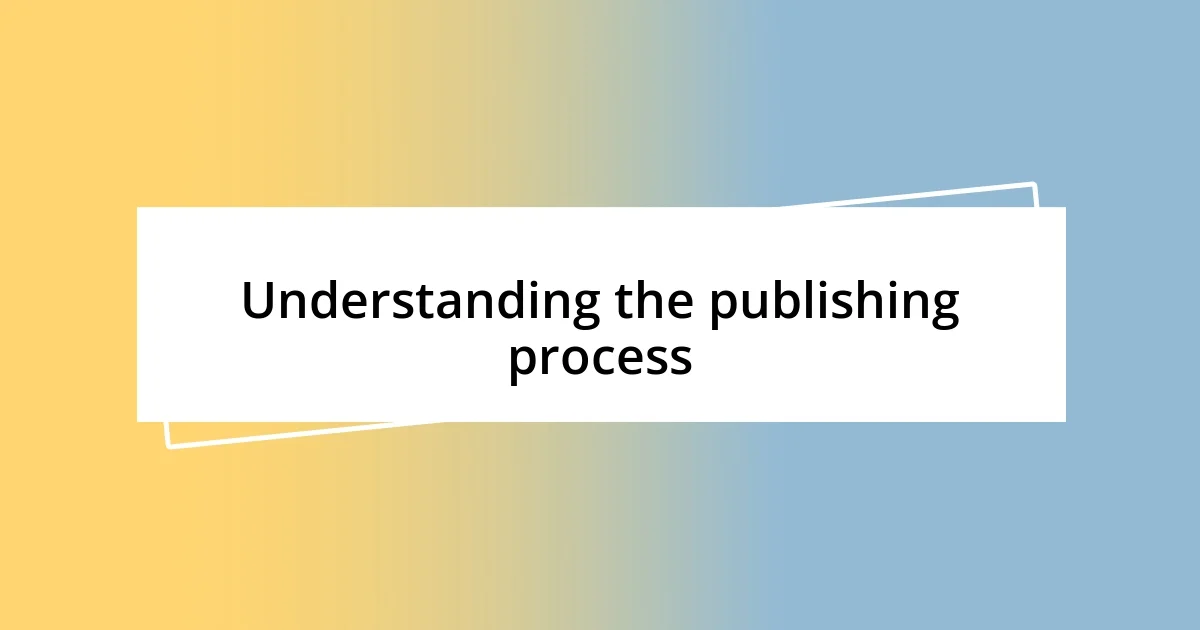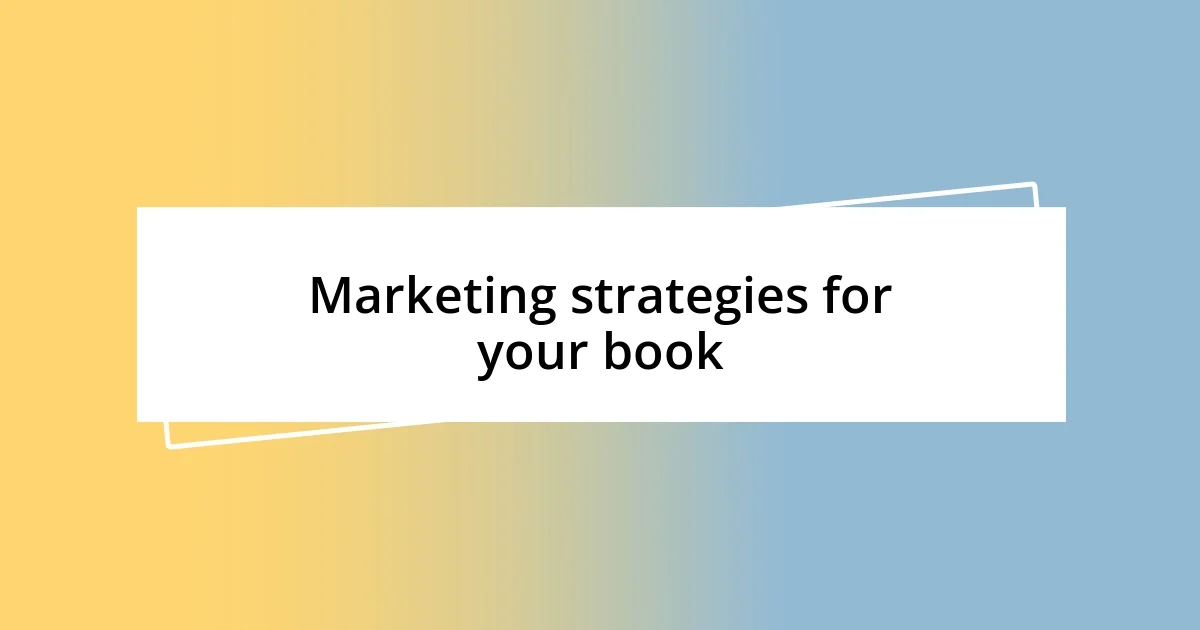Key takeaways:
- Understanding the publishing process, including the responsibilities and timelines of self-publishing vs. traditional publishing, is crucial for first-time authors.
- Engaging with your target audience, professional editing, and choosing the right publishing platform are key considerations that significantly impact a book’s success.
- Post-publication strategies, such as networking, gathering reviews, and marketing, are essential for sustaining interest and building a community around your work.

Understanding the publishing process
Understanding the publishing process can feel intimidating, especially for first-time authors. I still remember my first steps into this complex world. It was like navigating a maze without a map. Have you ever tried to piece together a puzzle where none of the pieces seem to fit? That’s exactly how I felt when trying to comprehend the various routes to publication.
One key takeaway I wish I had known earlier is that the journey is not just about choosing between traditional publishing and self-publishing; it’s about understanding what each path truly entails. For instance, when I opted for self-publishing, the responsibility for everything—editing, cover design, and marketing—landed squarely on my shoulders. Imagine juggling all those hats while still trying to write! It made me realize that understanding the nuances of each option upfront can save a lot of stress later on.
Another revelation I had was the timeline. The publishing process can be quite lengthy, often involving multiple rounds of revisions and approvals. I was so eager to see my work in print that I underestimated the time it would take. Did you know that some authors can wait months—or even years—before holding their finished book? Patience is not just a virtue; it’s a prerequisite in the publishing world.

Key considerations before publishing
Before you hit that “publish” button, there are crucial considerations that can greatly impact your success. One of the most significant pieces of advice I can share is to invest time in understanding your target audience. When I first published, I assumed my writing would appeal to everyone. It took me a while to realize that honing in on a specific reader demographic could shape not only my content but also how I marketed my book. It’s like trying to hit a bullseye; if you don’t know where to aim, it’s all too easy to miss the mark.
Another aspect that deserves your attention is the importance of professional editing. Early in my writing journey, I underestimated this step, thinking that my own revisions would suffice. However, I learned the hard way that a fresh set of eyes is invaluable. The difference between a rough draft and a polished manuscript is like night and day. A professional editor can provide insights that you, as the author, may miss because you’re too close to the work. It can feel daunting, but investing in this process can truly elevate your book.
The choice of publishing platform also weighs heavily on your decision-making. I remember standing in front of my computer, overwhelmed by the various options available—like print-on-demand and e-book services. This choice can affect your distribution and visibility significantly. I quickly learned that researching the platform that aligns with my vision was essential. Each option has its benefits and drawbacks, and understanding these can streamline the publishing process and ensure you reach the right audience.
| Key Consideration | Description |
|---|---|
| Target Audience | Identify the specific readers who will engage with your content to tailor your writing and marketing. |
| Professional Editing | Invest in a skilled editor to significantly enhance the quality of your manuscript. |
| Publishing Platform | Choose a platform that aligns with your goals and maximizes visibility for your book. |

Preparing your manuscript for submission
Preparing your manuscript for submission requires careful attention to detail. I remember poring over my manuscript countless times, but it wasn’t until I found a trusted reading group that I realized the importance of outside perspectives. Having fresh eyes on my work opened my mind to suggestions I hadn’t considered and highlighted areas that needed refinement. This collaborative effort transformed my manuscript from a personal project into a well-rounded piece ready for the world.
Here are some crucial steps to bear in mind when getting your manuscript ready:
- Formatting: Ensure your manuscript follows industry standards, such as font type, line spacing, and margins. This shows professionalism.
- Proofreading: After editing, give it a final proofread. Typos can distract readers and diminish the impact of your work.
- Query Letter: Craft a compelling query letter. This is your chance to pitch your work and make a strong first impression.
- Synopsis: Prepare a succinct synopsis that captures the essence of your book, highlighting its unique features and strengths.
- Beta Readers: Seek feedback from beta readers who represent your target audience. Their insights can be invaluable in gauging the book’s appeal.
Understanding these components transformed my approach and significantly increased my confidence when submitting. It’s all about presenting the best version of your work to potential publishers.

Marketing strategies for your book
Marketing your book is one of those areas where I wish I had known more from the outset. When I first published, I relied mostly on social media, thinking that a simple post would suffice. What I discovered was that you need a diversified strategy. Consider creating an engaging author website; it’s a fantastic platform to showcase your book, share your journey, and connect genuinely with readers. It’s like having your own space in the vast online world where you can invite people in.
Email marketing was another revelation for me. I remember feeling hesitant about asking people for their email addresses, but once I started building my list, I understood its value. Sending out newsletters with updates, bonus content, or even behind-the-scenes peeks can deepen your connection with your audience. It’s a direct way to reach them and keep the excitement alive about your work. After all, who wouldn’t love receiving exclusive insights directly from their favorite author?
Don’t underestimate the power of book blogs and podcasts, either. Early on, I was surprised by how receptive these platforms were to inviting me for interviews or guest posts. It’s an excellent opportunity to share your passion while reaching potential readers. Think about it: every time you communicate your story and expertise, you’re creating bonds and expanding your network. I can’t emphasize enough how each of these strategies contributed to my visibility and ultimately my book’s success.

Common mistakes to avoid
One of the common mistakes I see is underestimating the importance of a thorough editing process. I once thought that my first draft was good enough, but after sharing it with a professional editor, the depth of the necessary revisions hit me hard. It was a humbling experience to realize how much stronger my manuscript could be with additional, detailed work. Trust me, don’t skimp on investing time and effort in editing—it’s crucial.
Another mistake that can derail even the best-laid plans is neglecting to understand your target audience. Early in my journey, I focused more on my writing style than on who would actually want to read my book. It was a wake-up call when the feedback I gathered from a focus group revealed that I had missed the mark. Take time to research and connect with your intended readers; knowing their preferences can truly shape your work and marketing efforts.
Finally, I can’t stress enough the importance of setting realistic expectations. After my first book was published, I expected immediate success, only to find the journey slower than I anticipated. The patience I learned during that time taught me resilience. It’s vital to remember that building your audience and gaining traction takes time; embrace the journey rather than focusing solely on the destination.

Getting feedback from beta readers
Getting feedback from beta readers can be one of the most enlightening experiences I’ve had. I remember the first time I sent my manuscript out for review. The nervous anticipation was overwhelming! Receiving their thoughts made me realize how my story resonated differently with each reader, and that variety in perspective is invaluable. Wouldn’t you want to know how your work is perceived from different angles?
One of my biggest surprises was discovering how much detail beta readers notice. They pointed out inconsistencies and areas where my characters felt flat—things I’d overlooked entirely. At first, I felt a sting of disappointment, but then it dawned on me: their insights were a treasure trove of opportunities to improve. I learned to welcome their feedback, reminding myself that constructive criticism is about growth, not just validation.
I also found that choosing the right beta readers made a significant difference in the quality of feedback. I aimed for a mix of avid readers, writers, and even a few who had no prior knowledge of my genre. Each brought something unique to the table. It was fascinating to gauge how a non-reader experienced themes versus someone who was well-versed in the nuances of my genre. Have you thought about the different lenses your potential readers could provide?

Next steps after publication
I’ve always believed that the journey doesn’t end with publication; it’s merely the beginning. After my first book hit the shelves, I was buzzing with excitement, but the reality hit hard—I needed to pivot quickly into marketing mode. It was eye-opening to learn that creating a buzz requires more than just waving a banner; it takes strategic planning and genuine engagement with your audience. Have you considered how you’ll connect with your readers after launch?
Networking played a crucial role in my post-publication strategy. I vividly remember attending my first writer’s conference after launching my book. I was nervous, but reaching out to fellow authors and readers sparked invaluable conversations. Through those connections, I found opportunities for guest blogging, podcast interviews, and even speaking engagements. Building a community around your work amplifies its reach, turning initial readers into devoted fans. What steps are you planning to take to cultivate your network?
As my marketing efforts unfolded, I soon recognized the power of gathering and showcasing reviews. Initially, I was hesitant about asking for feedback, fearing rejection. But when I started soliciting honest reviews, it felt like opening a door to endless possibilities. Readers’ insights not only helped boost my book’s credibility but also created a sense of warmth and connection to those experiencing my story. Have you lined up some trusted readers to share their thoughts?












